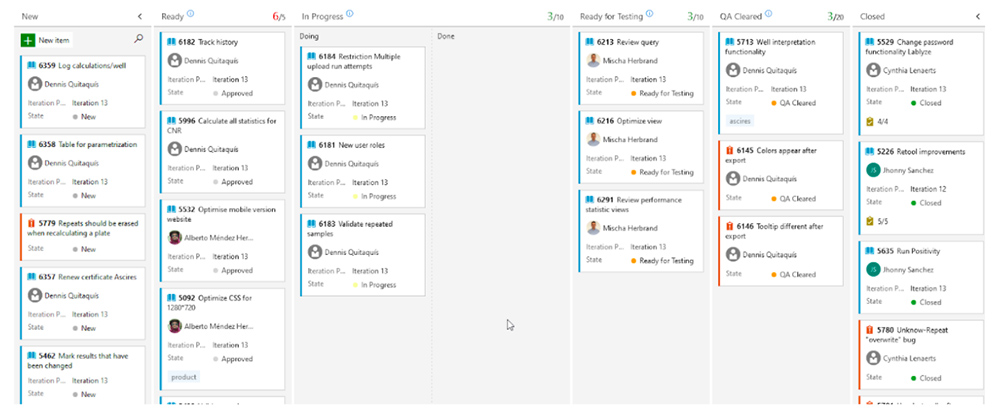What agile working looks like at Valudio
Key insights from this article
Adaptability and proactivity
Agile working enables companies to react quickly and effectively to changes and unforeseen events. Valudio succeeds in the increasingly complex and dynamic digital era thanks to this proactive approach.
More efficiency through teamwork and communication
The agile teams at Valudio are cross-functional, strengthening team spirit and promoting effective communication within the team. This helps to maximize customer benefit and achieve better results.
Valudio says yes to an open error culture
The agile way of working at Valudio promotes an open error culture, from which direct lessons are learned for future projects. Through monthly retrospectives, work processes and communication are continuously optimized, which contributes to the company's continuous improvement.
Early implementation of product optimizations
Valudio can react quickly to customer feedback and amend software products thanks to the agile working method. This ensures that Valudio creates solutions that are better tailored to the needs of end customers and thus offer real added value.
Agile working has long been an integral part of software development. It’s the foundation of every developer’s working process. However, the implementation of agile working methods varies significantly between companies, and the differences offer new ways of working. While some only use agile software development to make one process more efficient, others live the four agile guiding principles to their fullest, making them a part of their company cultures.
So, what exactly hides behind the buzzword ‘agile’? And what do adaptability and flexible working look like at Valudio? Read on to find out.
What is agile working?
Agile methodology enables an immediate response to the unplannable within a process. The digital age challenges us to react quickly to increasing complexity and dynamics. Introducing an agile workspace means we are well-equipped to tackle this challenge.
Agile companies act proactively and anticipatively. This means they try to anticipate and prepare for a highly uncertain future. At the same time, they can immediately redirect if a chosen path turns out to be a dead end.
‘Nur die Agilen werden überleben’ von Horst Wildemann, 2018
Although the term itself is not new, agile working has seen a recent spike in popularity. It is becoming mainstream in office spaces across the globe, especially in the software development field. This represents a move away from assumptions that almost everything is predictable — or that clients know what they need and want. While markets constantly change, working with an agile approach means reacting quickly to dynamic circumstances.
Given the software development field’s iterative way of working, companies use methods such as Scrum to ensure their development teams have the greatest possible freedom to give their intellectual and creative potential enough room to flourish.
In addition to applying methods like Scrum, an agile culture defines individual project management and how a company is managed and aligns itself with its customers. Instead of deciding from the top down, end users get involved throughout the development process.
Mischa Herbrand
CEO, Valudio
Adopting an agile working method does not inevitably make you an agile company.
As a developer, you start with an assumption about what end users might be interested in, but you only learn if you are right once the product is trialed on the market. The first goal for an agile software company is to understand what end users need and what works best for them.
What are the benefits of agile working?
The first advantage of flexible working can be observed when a product hits the market: feedback is immediate. Agile programming means iterative, phased software development that makes it possible to react immediately to the unforeseen.
Working in iterations at Valudio means we divide our work into two-week sprints. A product should already be functionally applicable at the end of a sprint. The focus is always on creating value for the end user — from the first software version onwards.
Agile vs. traditional work
The advantage of agile vs. traditional methodology lies primarily in its effectiveness. In conventional methods, such as the waterfall method, development process steps are strictly set, one after the other. A product is developed by the team members and then tested. If, at this late stage, a bug or the need for a revision becomes apparent, the product has to be redeveloped. In the worst case, this happens several times, which costs a lot of time. Another risk is carrying out weeks of analysis specification and code writing only to discover that the client no longer needs the resulting software version. Markets could have already moved on. Further adjustments would be required.
At Valudio, we set up agile teams cross-functionally. Product owners, UX designers, QA and DevOps engineers make an integrated team. The goal is to avoid people working solely on their own defined area. Instead, the individual steps are considered and discussed by everyone involved. This not only fosters a sense of responsibility for a project but also helps to ignite team spirit, flexible working hours, and hybrid working and promotes internal agile communication.
Promoting an open error culture
The agile way of working allows mistakes to be made and capitalizes on them. Mistakes, or moments of not getting anywhere, are essential because it's the only way to learn what works and what doesn't.
At Valudio, we hold a monthly joint retrospective to examine what went well and what could have gone better and to learn from this for future projects.
Doing so ensures that our work processes and communication are continuously optimized.
Ready for agile working?
Let us transform your software projects.
Agile working at Valudio
We usually recommend our clients start with smaller projects — to roadmap and define the first steps and goals — especially if there is a significant initial idea.
Roadmapping can take place within the framework of a workshop. To gain holistic input, we involve participants from all relevant areas, including customer service, business management, technologies, and end users.
Organizing projects into small steps makes work volumes and associated costs more manageable. Together, we focus on the essentials and eliminate any redundant steps.
Typically, we start with fixed-scope projects and then move on to continuous collaboration. Depending on availability, New requirements flow into our next cross-project sprint planning.
Initially, it’s all about getting to know each other and building trust. This way, our potential clients can decide to work with us without risk. This is important to us on both a human and a business level.
If a client gets to see progress in short intervals, it creates trust.
Mischa Herbrand
Agile tools we use at Valudio
We divide each new project into features representing shippable software components or milestones. Features are then further refined into user stories, the smallest deliverables. Features and user stories are stored in the project backlog. This backlog helps our team prioritize work, self-organize, and plan sprints.
During the sprint planning meeting, the team decides on the user stories to be developed. These are visualized on a Kanban board to provide a clear overview of their progress throughout the sprint. The Kanban board also helps us to optimize our workflow and team communication. We hold a standup twice a week to discuss the sprint's progress. This allows us to quickly identify blockers, problems and dependencies that must be resolved.

Each month, we hold a retrospective to review the way we work. We identify what went well and what went wrong and list action points. This ensures that we keep doing what goes well, keep improving, and stop doing what holds us back.
The tools we employ help to manage development processes more specifically, focusing on the correct elements at the right time to deliver a project faster and more effectively.
Interested in building software the agile way?
Reach out to us.
Agility in work cultures: which companies dare to transform?
Just 10% of companies in Germany work agilely, according to a study carried out by the Kienbaum Institute @ISM in cooperation with job platform StepStone. Those that form the 10% are primarily start-ups and companies in the digital sector.
The study's authors see a connection between digital leadership competence, organizational agility, innovation and performance. They recommend that companies rely on agile methods, especially for their innovation processes. Employees are willing to do so — every third study participant favors an agile workplace, and most of the 10,000 responders are open to agile methods, such as Scrum or Kanban.
So, why do companies often struggle with transformation towards an agile work environment? According to the abovementioned study, one common reason sits at the management level. Although more than two-thirds of managers are familiar with agile methods, they find it difficult to break with traditional practices and hierarchies or dare to step into an error culture.
However, now is the time to dare! Agile-defined companies state that their innovation and performance benefit significantly from agility. We strongly endorse this conclusion and are optimistic about an agile, digital future.
Some basics of agile working explained
Scrum
Scrum is the name of a process model for digital product development and is used, in particular, in agile software development.
Agile Manifesto
The Manifesto for Agile Software Development was written by software developers in 2001 with four guiding principles:
- Individuals and interactions before processes and tools
- Working software over comprehensive documentation
- Customer collaboration over contract negotiation
- Responding to change by following a plan
(Source: agilemanifesto.org)
Want to learn more?
We recommend reading ‘Clean Agile: Back to Basics’, by Robert C. Martin Series.





